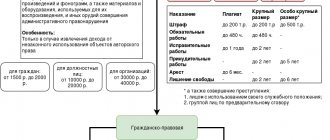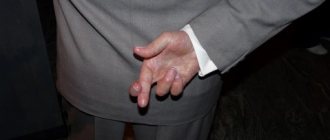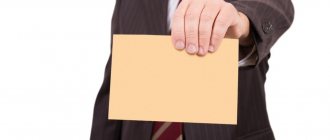We have already written about the uniqueness and protection of original content. Today we’ll take a closer look at how to protect your content from a legal point of view.
Theft of content (and copyrights to it) occurs all the time on the Internet. This cannot be avoided. Although no, there is still one way - not to publish anything at all. =)
Unfortunately, the content has been copied, is being copied and will continue to be copied.
And if it is impossible to prevent theft, then you can prepare to defend violated rights. So, in order.
What does copyright protect?
It is necessary to protect not only music, poems, paintings, but also comics, photographs, scripts, design compositions, sewing patterns, etc. Everything created by creative work is protected by copyright. Copyright automatically arises from the moment the work is created.
Objects of copyright are listed in Article 1259 of the Civil Code. Not all objects are listed in the article; in fact, there are more of them. The law cannot provide for all possible works. For example, a meme or a joke is not listed in article 1259, but even they are protected by copyright. After all, this is the result of creative work.
Both the entry and the commentary on it can be considered an author's joke, which is protected by copyright. However, it can be difficult to identify the author of a joke on the Internet.
A little tediousness: let's go over the articles of the Civil Code
Let me explain a little: the site (entirely), content from the site, photographs, pictures, videos - all this is subject to copyright.
But what does this beautiful formulation “creative work” mean? Every author who writes, photographs, draws, or comes up with a script, essentially has a mental process going on. He first comes up with an idea and then implements it. Mental processes prevail over physical ones, so this is creative work. If a person helps the author, for example, financially or assists in filming, then this is considered technical work, and in this case one cannot claim co-authorship. But if you give ideas, add to it or come up with something new, then please – you are a co-author.
And copyright in a work arises automatically at the moment of its creation.
Now let's figure out exactly what rights the author has. Traditionally, rights are divided into personal and property rights .
Also, the copyright holder may, at his own discretion, permit or prohibit other persons from using the result of intellectual activity. In this case, the absence of a prohibition is not considered consent/permission .
Note: the author and copyright holder are not always the same person. The author is the person whose creative work created the work. But the copyright holder can be either an individual or a legal entity. Since the law does not prohibit the alienation of rights in favor of other persons, the copyright holder has the exclusive right to the work.
Alienation of rights can be either in full or in part. And alienation occurs on the basis of a contract. For example, in the Service Agreement that we conclude with Customers, there is a clause that regulates relations in this area: “Exclusive rights to use the design, texts, illustrations and other materials developed in accordance with this agreement belong to the Customer (that is, the client) and are transferred to him after the Contractor (that is, us) completes the relevant work"
.
Does copyright protect an idea?
It would be a shame not to use a good idea. Entrepreneurs love to borrow other people's ideas and build their own businesses based on them. It's easier than coming up with something completely new. If one entrepreneur took the idea of another and created his own business, there is no reason to punish him.
But if an idea takes the form of an invention or utility model, then it can be patented.
For example, the tweed jacket was invented by the legendary Coco Chanel. Branded jackets from Chanel cost a pretty penny. Individual entrepreneur Olga produces tweed jackets at her sewing factory, which cost 1,500 - 2,000 rubles. Olga was inspired by the idea of a French fashion designer and produces clothes that are accessible to any girl.
Let's imagine that the director of a clothing factory snuck into Chanel's workshop at night and copied papers containing a unique production technology. Now his tweed jackets are absolutely identical to Chanel jackets. The director did not violate copyright, but he did violate patent law. And he also committed a criminal offense.
Industrial inventions and models are protected by patent law. If the production process of a product is specifically described and is novel, it can be patented as a utility model. Stealing the drawings means violating the rights of the patent holder.
There are ideas that cannot be protected even by patent law. One entrepreneur came up with the idea of packing socks in cans. He wanted to stop anyone from doing this again and tried to patent “canned socks.” Then anyone who repeated the idea would have to pay him a reward. However, nothing came of it. If he started doing this, he would be surrounded by manufacturers of canned pineapples and canned peas. And everyone would unanimously defend their right to packaging in jars.
How does misconduct manifest itself?
Typically, copyright infringement in Russia is also called counterfeiting. There are concepts of plagiarism and piracy. The terms apply equally to any copyright infringement. They are relevant for situations when a work or part of it is used, although the creator did not give explicit consent.
Reference! Piracy is illegal copying. It doesn't matter whether it has commercial purposes or not. However, the quality of the recording is usually very different from what the original gives.
What copyright does not protect and what will not be considered an infringement of the rights of others
Copyright does not protect everything. In paragraph 6 of Art. 1259 of the Civil Code lists objects that are not protected by copyright. These are court decisions, flags and coats of arms, news and minibus schedules, popular toasts and jokes. Such objects can be distributed and used.
For example, Ivan is an individual entrepreneur who hosts weddings and corporate events. Once Ivan led an Abkhazian wedding attended by a thousand people. During the program, he said: “A sage was asked: When is the relationship between husband and wife good? When the husband does not hear what his wife says, and the wife does not see what her husband is doing, answered the sage.” It was a toast, i.e. folklore that does not have a specific author. Ivan did not violate anyone else's copyright. If Ivan passed it off as his own joke, which he spied on someone else’s Twitter, he would have violated the author’s rights.
Copyright does not extend to ideas, concepts, methods and processes, discoveries and facts. For example, TV show developers suffer from this norm. In some countries - Great Britain, USA - the concept of the show can be protected. But not in Russia and not in other countries of the Romano-Germanic legal family. Therefore, the developers of the TV show America's Next Top Model are unlikely to be able to do anything about the fact that the concept of their show is completely repeated by Ukraine's Top Model. Foreign copyright holders of television program formats have repeatedly sued Russian television companies producing analogues and lost due to this rule.
What is not copyright infringement
The law allows that sometimes copyrighted objects can be used without the permission of the copyright holder. And the author does not need to pay any remuneration. The most common cases of using other people's works are quoting and parody. They are not considered a violation of the law.
Citation.
The law allows that other people's quotes will be used for scientific, educational or journalistic purposes. But the length of the quotation must be justified by such purposes. If it comes to court, the justification of the citation will be determined by the court. Use quotations thoughtfully and always credit the author.
For example, the author of this article liked the quote from a copyright expert so much that he decided to publish it in his VK legal group. The author of the article indicated that the quote belongs to another person. The group was created specifically to clarify legal issues, so the quote is appropriate here. Such use does not constitute copyright infringement.
And if the author of the article had posted a quote in a group about suspended ceilings, and, moreover, passed it off as his own, then Andrei Makarov would have grounds for a claim.
Parodies.
Article 1274 of the Civil Code allows the creation of parodies without the consent of the copyright holder. But there are two points that are better understood with an example.
For example, Ksenia, the owner of a beauty studio, recorded a video to advertise her studio. In it, one of Ksenia’s employees parodies Olga Buzova and invites clients to the studio. A parody of a famous person will never entail copyright infringement, since a person cannot be the object of copyright.
Ksenia recorded a video in which her employees parody not Olga Buzova herself, but her song “Not enough halves.” A song is an object that is protected by copyright. If Buzova files a lawsuit, Ksenia will have to prove that the song in the video is just a parody.
Other exceptions are listed in Article 1274 of the Civil Code.
A little practice
I will give you a couple of examples of disputes over the protection of intellectual property.
With Alyonka everything is sweet and smooth
Dispute between OJSC Moscow Confectionery Factory “Red October” and CJSC “Confectionery Factory “Slavyanka”, which is associated with the brands of chocolates “Alenka” and “Alina”. It was about the design of the chocolate packaging.
“Red October” demanded compensation of more than 310 million rubles (!!!) from “Slavyanka” for violation of exclusive rights to a trademark. According to Red October, Slavyanka produced Alina chocolate, the design of which is “confusingly similar to the label of Alenka chocolate.”
.
A representative of “Red October” even presented to the court a study by VTsIOM, which found that “Alenka” and “Alina” chocolates are perceived “as products from the same manufacturer’s line
.
The proceedings ended with the signing of a settlement agreement: “Slavyanka” undertook to stop producing chocolate bars in the controversial design, and also to pay “Red October” 15 million rubles.
And again about treats
In 2007, the Ferrero group filed a claim with the Moscow Arbitration Court for violation of the exclusive right to a trademark protecting the appearance of Raffaello sweets. The defendants in the lawsuit were Landrin CJSC and the retail trade enterprise Chakuba LLC (Moscow). The company Soremartek SA (part of Ferrero) has registered a trademark in its name, which is a realistic image (photograph) of a white spherical candy with an uneven surface - sprinkled with coconut flakes.
As a result of the legal proceedings, all four instances of the arbitration system confirmed Ferrero’s exclusive right to the Raffaello brand.
Your song is sung
But here is a very interesting story about how the protection of intellectual rights works outside of Russia:
“Happy birthday to you” - which of us has not sung these words at least once in our lives as a birthday greeting? =) But the commercial performance of this song without royalties to the copyright holder is prohibited in the USA. That is why you rarely see this song, for example, in American films (because it is expensive). The song was written by sisters Patty and Mildred J. Hill (they wrote the song in 1893). The rights to the song were transferred to the sisters' relatives. Officially, the copyright for the song “Happy birthday to you” was registered in 1935 and, according to US law, will expire by 2030.
You will find even more similar stories in the following sources:
- Review of judicial practice in cases related to the resolution of disputes on the protection of intellectual rights, approved by the Presidium of the Supreme Court of the Russian Federation on September 23, 2015.
- Review of judicial practice on some issues of the application of copyright rules by courts
Here are various controversial situations and solutions to them.
How to protect your copyrights
It would seem that the law reliably protects trademarks, patents, works, and inventions. However, their rights are regularly violated. To avoid this, it is better to secure your creation.
Deposition is ideal for protecting copyright objects. Depositing is the storage of a sample of an author's work. “Deposit” means giving a copy of an author’s work to someone for safekeeping. Previously, model versions were kept by a notary or post office, to whom a copy of the work was sent in a sealed envelope. Now these are specialized organizations.
Modern works of authorship are stored electronically. Since there are many works, they are combined into a register. In case of a dispute, you can request a copy from the register through a judicial request. The keeper of the register will inform the court of the date on which the original was provided. The earlier copy will be considered genuine.
Previously, the Russian Copyright Society provided the deposit service. As of 2021, RAO no longer does this. Now there are several independent automated registries for the deposit of copyright objects.
RAO recommends using two services: Technology Platform LLC IREG and National Register of Intellectual Property JSC n'RIS.
To deposit a work in IREG, you need:
- Register on the site: enter your full name, email address and create a password.
- Register an object: specify the name and add a file with the work in the latest edition. If you want to make changes, you will have to register the object again.
- Pay. Registration of one file weighing up to 250 MB will cost 1,000 rubles.
- Receive a certificate of escrow.
The work will be protected for 70 years.
The deposit procedure in n'RIS is similar. The cost of the service starts from 990 rubles.
You can also use the copyright symbol © and various warning notices to prevent violations. But this does little to deter potential violators.
Concept
An author is a person who created a work. The latter refers not only to things that have become world-class masterpieces. The term applies to all materials:
- Comics.
- Photos.
- Commercials.
- Small articles on social networks.
When publishing their information, authors count only on positive consequences. But many are faced with the fact that content simply begins to be stolen.
Free legal consultation
+8 800 100-61-94
Copyright is:
- Ownership of an object.
- Disposition at your own discretion.
- Protection of any works that are the result of labor.
Attention! The law must protect the interests of authors, the result of whose work is intellectual property.
The items for such protection are:
- Derivatives of the work and collections, other components of the work.
- Operating systems of all forms and languages.
- Maps, plans and sketches, other types of creations that relate to topography and similar sciences.
- Photographic works and other materials obtained in this way.
- Subjects related to landscape art and urban planning, arts and crafts and scenographic areas.
- Painting and sculpture, graphics and design, graphic stories and comics.
- Audiovisual phenomena.
- Scenario and drama.
- Literary works.
There are objects to which copyright cannot apply:
- Short titles along with slogans.
- Informational messages.
- Works related to folk art.
- Symbols and signs related to the state.
- Official documents.
What to do if copyright is violated
Konstantin Ivlev came into your cafe, ate soup and took a photo in front of the establishment. You posted this photo in the VK group, Instagram and Facebook. This is great advertising for you. Soon you saw your photo on the website of a competing cafe. Your copyright has been violated. Procedure in such a situation:
- File a claim. If the author and the violator are an individual entrepreneur or a legal entity, a claim is mandatory. The procedure for filing a claim is free. State the essence of the violation and clearly formulate the requirements. You can demand to remove the photo, provide attribution and a link to the author’s website, or pay monetary compensation. According to Art. 1301 Civil Code, compensation ranges from 10 thousand rubles. up to 5 million rubles Usually, for 1 photo the author demands to pay 10-20 thousand rubles.
- Before sending a claim to the infringer, contact a notary so that he can document the fact of copyright infringement. It happens that the violator receives a complaint and immediately deletes everything from the network. And he doesn't pay any compensation. Then you need to go to court, and without a notary examination you won’t be able to prove anything.
- Submit a claim. It is better to send not by e-mail, but by letter with acknowledgment of delivery. This way, the violator will have less chance of citing the fact that he did not receive the claim.
- If the violator ignored the claim or did not agree with the requirements, go to court. In court, be prepared to prove your authorship. Therefore, always leave watermarks on your photos. A certificate of deposit will also be useful.
Copyright infringement disputes are not uncommon. Courts often side with the authors and award varying amounts of compensation.
What is a violation
With regard to copyright, the following types of violations are distinguished:
- Reworking of a work or plagiarism.
- Translation of the work into other languages.
- Broadcasts on radio and television.
- Public performance.
- Public display of a different kind.
- Spreading.
- Copying.
Fraudsters do not develop a unique idea. On the contrary, they are looking for ways to appropriate other people's developments.
The copyright holder himself usually determines the extent of the violation in a particular case. Therefore, the courts consider any action that raises additional questions. Based on the results of consideration of the issue, a decision is made on whether to bring the offender to justice or not.
Interesting cases
For example, quoting.
The Federal Channel is making a movie about the impact of palm oil on human health. A fragment of another material devoted to the creation of fat substitutes was used. But the author did not agree to have his work used. In this case, the channel did not violate the citation requirements, so there was no final punishment.
In this case, the purpose of the citation is strictly informational, since it is used as part of an investigation by journalists. The plaintiff's film was made public or posted on Youtube. The author is indicated, both films are similar to each other in their themes. The volume of quoting is justified and does not violate anything.
In another case, the owner still won the dispute - because the citizen used an image from the cartoon “Peppa Pig” without filling out the appropriate papers. And the entrepreneur only sold toys, which were made in the form of the character.
In Moscow, you can win at least 10 thousand rubles for violators who appropriate other people's photographs or even put watermarks on them. There are many cases where amounts from 25 to 80 thousand rubles were awarded.
For example, a photographer in Karachay-Cherkessia received about 800 thousand. His photographs were illegally used to advertise Arkhyz water. The company used the photographs, although it refused to pay the photographer when he did the work for it.
Arbitrage practice
For example, there was one case when the copyright holder demanded an amount of 120 thousand rubles for the illegal use of a video game. In particular, other people offered to buy this game online, although they were not the creators. The defendant did not waive the plaintiff's demands. But the court eventually decided that compensation of only 10 thousand rubles was needed.
Important! Due to such circumstances, copyright holders often include double the cost of claims when drawing up documents from the very beginning. The main thing is that the crime and violation itself involve the use of one or another method for settlement.








